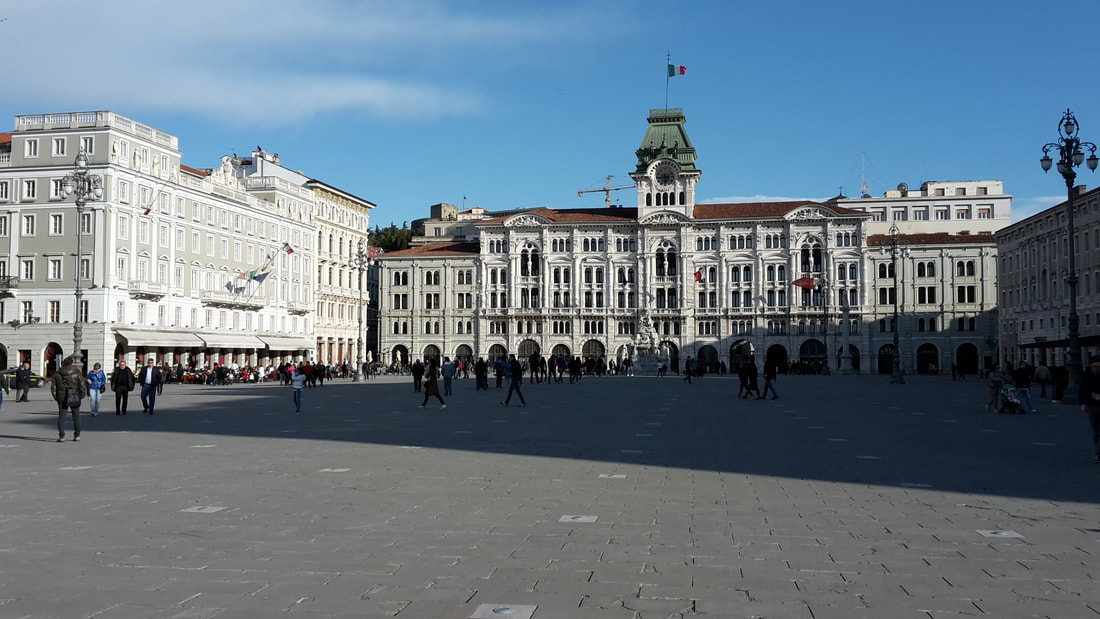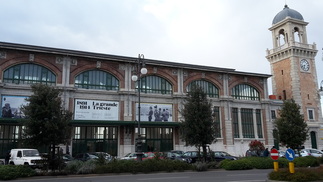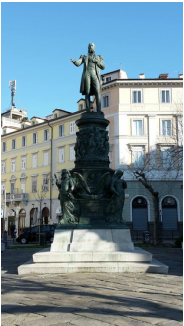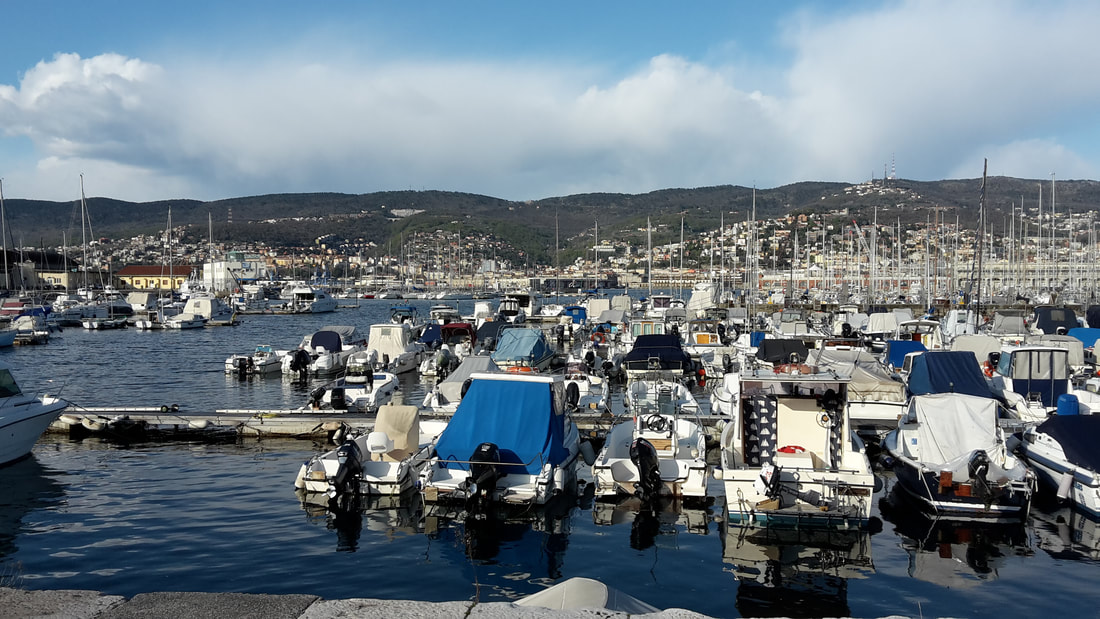I picked up the van from Treviso airport this afternoon, and finding no problems, headed for Trieste.
This was an easy 140km motorway journey, and although I started in mid-afternoon, I had plenty of time in the late afternoon to explore Trieste a little.
On the way the whole range of Alps were close to my left,although where the Dolomites ended and the Julian Alps began I was not sure. The motorway runs through the flat Veneto plain with orchards and vineyards the whole way.I was conscious of a large stream of campervans heading in the opposite direction. Perhaps they know something I don't-although I suspect they are Italians vacating the Istrian coast after their Easter weekend .
I am aware that the countries I have visited so far, being in Western Europe, have been a "safe" aperitif to the journey, useful for getting any issues ironed out.I am fascinated by the countries next to come,for,even though they are all in the EU or applying to join, they have a history of huge and multiple changes to their boundaries and their rulers over time.
To this concept,Trieste,while part of Italy since 1918,makes an interesting introduction.Trieste was the major port of the Austro-Hungarian Empire and was an "open port",although the main base of the Austro-Hungarian navy was actually in Pula, Istria,now part of Croatia.Trieste was the fourth largest city in the Empire,after Vienna,Prague and Budapest..
Having always had an Italian influence,especially as part of the Venetian Empire, Istria was coveted by the Italians and nationalistic fervour in Italy led to the Italians entering the First World War on the side of the Western Allies particularly to win the provinces of Trento and Trieste from the Austro-Hungarians.At the end of WW2 the Yugoslavians under Tito took back most of Istria but Trieste remained in the West after a scramble by the British to save it from falling to the the communist bloc. The agreement was that it become a "free territory" and it was ceded formally back to Italy only in 1955.It is on a little strip of land almost completely surrounded by Slovenia. The romantic image Trieste puts out is that of its heyday as a resort for the Austro -Hungarians and hang-out of poets ,Bohemians, and as a melting pot of Latin, Slavic, and Germanic culture,in the belle epoque,or fin-de siècle period; I was pleased to find in the Victorian-era aquarium building on the harbour front a photographic exhibition of just those years,1891-1914.
An interesting indicator of the cultural phenomenon was that from about 30km before Trieste ,all the roadsigns,and signs on big buildings like banks,are bilingual in Italian and Serbo-Croatian.
My camper guide led me to a car park on the main harbourfront, and I am parked up right on the waterside overlooking the yachts. As an extra bonus it is free as there is no charge on bank holidays. There is the slightest of inclines towards the water so I hope the handbrake holds overnight! .It was a nice sunny evening to stroll along the main seafront parade, and into the main square overlooking the harbour,now called Piazza Unita d'Italia (since 1918).
This was an easy 140km motorway journey, and although I started in mid-afternoon, I had plenty of time in the late afternoon to explore Trieste a little.
On the way the whole range of Alps were close to my left,although where the Dolomites ended and the Julian Alps began I was not sure. The motorway runs through the flat Veneto plain with orchards and vineyards the whole way.I was conscious of a large stream of campervans heading in the opposite direction. Perhaps they know something I don't-although I suspect they are Italians vacating the Istrian coast after their Easter weekend .
I am aware that the countries I have visited so far, being in Western Europe, have been a "safe" aperitif to the journey, useful for getting any issues ironed out.I am fascinated by the countries next to come,for,even though they are all in the EU or applying to join, they have a history of huge and multiple changes to their boundaries and their rulers over time.
To this concept,Trieste,while part of Italy since 1918,makes an interesting introduction.Trieste was the major port of the Austro-Hungarian Empire and was an "open port",although the main base of the Austro-Hungarian navy was actually in Pula, Istria,now part of Croatia.Trieste was the fourth largest city in the Empire,after Vienna,Prague and Budapest..
Having always had an Italian influence,especially as part of the Venetian Empire, Istria was coveted by the Italians and nationalistic fervour in Italy led to the Italians entering the First World War on the side of the Western Allies particularly to win the provinces of Trento and Trieste from the Austro-Hungarians.At the end of WW2 the Yugoslavians under Tito took back most of Istria but Trieste remained in the West after a scramble by the British to save it from falling to the the communist bloc. The agreement was that it become a "free territory" and it was ceded formally back to Italy only in 1955.It is on a little strip of land almost completely surrounded by Slovenia. The romantic image Trieste puts out is that of its heyday as a resort for the Austro -Hungarians and hang-out of poets ,Bohemians, and as a melting pot of Latin, Slavic, and Germanic culture,in the belle epoque,or fin-de siècle period; I was pleased to find in the Victorian-era aquarium building on the harbour front a photographic exhibition of just those years,1891-1914.
An interesting indicator of the cultural phenomenon was that from about 30km before Trieste ,all the roadsigns,and signs on big buildings like banks,are bilingual in Italian and Serbo-Croatian.
My camper guide led me to a car park on the main harbourfront, and I am parked up right on the waterside overlooking the yachts. As an extra bonus it is free as there is no charge on bank holidays. There is the slightest of inclines towards the water so I hope the handbrake holds overnight! .It was a nice sunny evening to stroll along the main seafront parade, and into the main square overlooking the harbour,now called Piazza Unita d'Italia (since 1918).
I had wondered how Trieste might compare with Genoa ,but while there were plenty of signs of a busy port(many ships waiting in the Gulf outside the harbour) the city has much more of the air of a resort to it, with a wide open boulevarded harbour-front faced by grand Austro-Hungarian buildings, and attractive hillsides leading down to the city dotted with villas and houses. As I was when I was in Genoa, I was tempted to eat in a harbour-front seafood restaurant: again a very good meal.





 RSS Feed
RSS Feed